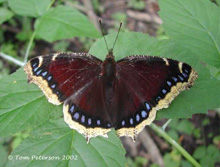 |
Monday, February 20, 2006 |
 |
| The Mourning Cloak (Nymphalis antiopa) overwinters as an adult butterfly. (Image courtesy of Tom Peterson; click for larger version.) |
Where do butterflies go in the winter? While a few species, like Monarchs, migrate to warmer climates, the majority of species spend winter wherever they are, in a metabolic state similar to hibernation called diapause. More than 50 butterfly species regularly call Fermilab home and most of them are here even now, just not in the form you may imagine. Butterflies have four stages in their life cycle--egg, larva, pupa, and imago (adult butterfly)--and while you might think they would spend winter as pupae in a cocoon or chrysalis, you'd be only partly correct.
"Actually, all four stages are out there right now," said cryogenics engineer Tom Peterson, the lab's resident butterfly expert and newly appointed ELM committee chair. "While every species typically has one pattern and overwinters in the same stage every year, right now, there are even adult butterflies sitting in the woods, hiding in trees." Local species that overwinter as imago include the Eastern Comma and Mourning Cloak. Both have cryptic coloring, which camouflages them and is the only real way an animal in diapause can avoid predators.
Other species, like the Great Spangled Fritillary, overwinter as larvae (caterpillars), sometimes going into diapause immediately after hatching from an egg. Caterpillars can be enormously sensitive to environmental changes, particularly in humidity and temperature. "The warm, wet weather we've been having is probably not going to be bad for them, but snow cover is beneficial because it protects them from the extremes in temperature," Peterson said. "If we have no snow cover and it turns really cold, or if it were very dry and cold, it will be hard on them." More information can be found on the Butterflies of Fermilab Web page.
—Dawn Stanton